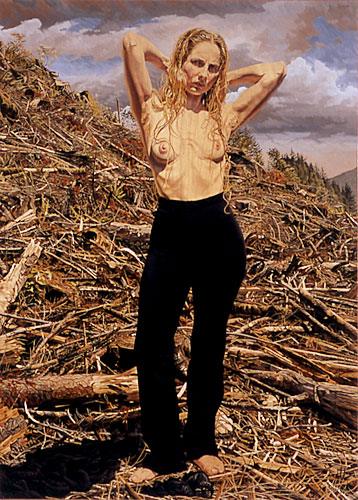Vanity Suite is an installation of four life-size figurative paintings that engage both the religious and art historical interpretation of the Three Graces.
According to Christian theology, Faith, Hope and Charity name the theological virtues that are divine gifts to those, upon whom, God bestows his grace. They are the three Cardinal Christian Graces.
According to Greek mythology the Three Graces are the goddesses of joy, charm and beauty. They presided over pleasurable social events and brought joy and goodwill to both God and mortals alike. Together with the Muses, they sang and danced to the gods on Mount Olympus. The graces were rarely treated as individuals but always together as a kind of triple embodiment of grace, joy and beauty. Like the muses, they were believed to endow artists and poets with the ability to create beautiful works of art.
In Vanity Suite, one male and three female figures, surrounded by the ruins of a west coast clear cut, are engaged in the drama of a striptease. On three separate paintings female figures, each in a stage of undress, stand alone in this baren landscape. Across the room on the opposing wall, a clothed male figure stares back at them, as he steps out of the clear-cut and into the forest beyond. No longer desiring the graces gifts or the goddesses charms. The scene is interrupted though when a viewer enters the gallery space and unknowingly steps into the middle of the “action”. Consequently becoming the cause of it’s completion.
This is a landscape of destruction and compromise that describes innate human behaviors. The work’s focus is on the voyeuristic pleasures that objectify the genders and contribute to the formation of sexual identity. It is a metaphoric performance about virtue, goddesses and muses. A stage that displays vulnerability, confrontation and confusion within the shifting nature of sexuality.



